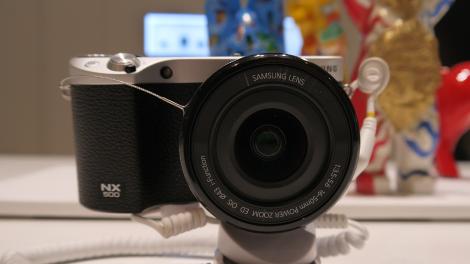
Introduction and features
The Samsung NX1 that the NX500 is based on has the type of feature set that is designed to grab the attention of enthusiast photographers. For a start, its APS-C format CMOS sensor is backside-illuminated (BSI), which means that the photo receptors (pixels) can be made larger to improve their light gathering potential. What’s more, the sensor has 28.2 million effective pixels, giving the NX1 the highest resolution of any APS-C format camera currently available.
Add to this the fact that there’s a hybrid autofocus (AF) system with 205 phase detection points (153 cross type) and 209 contrast detection points, 4K video recording and a maximum continuous shooting rate of 15fps (frames per second) and you start to see what all the fuss is about.
Now Samsung has taken many of the most important aspects of the NX1 and put them in a smaller, more affordable NX500 – which replaces the NX300.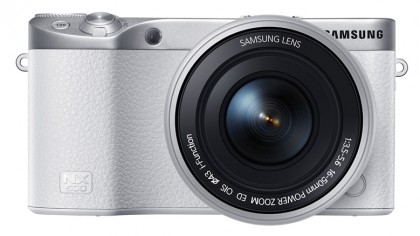
Features
Significantly, the NX500 has the same 28.2Mp APS-C format BSI sensor as the NX1, along with a slightly pared back version of the DRIMe V processing engine. This engine enables a maximum continuous shooting rate of 9fps for 40 JPEGs or 5 raw files (when a UHS-1 SD card is installed) before the rate slows. While this is slower than the NX1, it’s still quite a lick and faster than most CSCs or DSLRs can manage at full resolution and with continuous autofocusing. Exposure is set at the start of the sequence, but that is unlikely to be an issue in most instances.
Sensitivity may be set in the native range ISO 100-25,600 with an expansion setting of ISO 51,200 for stills. This drops to ISO 100-6400 for video.
There’s also the same hybrid AF system as is found in the NX1. And, as in the NX1, this combines with the processing engine to enable the inclusion of Samsung Auto Shot (SAS) mode with its rather unusual Baseball and Jump Shot mode, along with a new Trap Shot mode.
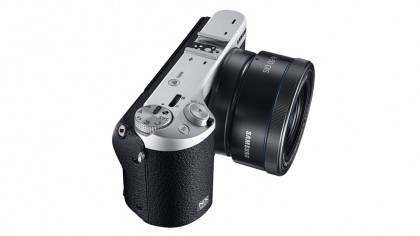
Baseball mode is designed to take a shot at the moment the ball hits the bat in a baseball game and in Jump Shot mode the camera takes a photograph when the subject is at the top of a jump. In Trap Shot mode the camera takes a photo when it detects the subject is moving in the direction of the on-screen arrow and it reaches a set point. As it requires the subject to move in a particular direction, it could be of rather limited use for shooting wildlife, but it could work well for running races and the like.
One key difference between the NX1 and the NX500 is that the NX500 doesn’t have a viewfinder. However, the 3-inch, 1,036,000-dot Super AMOLED touch-sensitive screen on the back of the camera is the same. Again, this is mounted on a tilting bracket to make it easier to view from high or low angles when shooting landscape format images. It can be tipped right up to allow viewing from in front when shooting selfies.
4K video
Taking another leaf from the NX1’s book, the NX500 can record Full HD (1920×1080), UHD (3840×2160) or 4K (4096×2160) video in MP4 format with HEVC compression. AVI format with MJPEG compression is used when recording VGA footage. The maximum bit rate for 4K recording is 36Mbps (at 24p), but 40Mbps is possible with UHD (at 30 or 25p) footage. Samsung claims that its HEVC codec enables high image quality despite these conservative bit rates.
Full HD footage can be recorded at 60, 50, 25 or 24p. Helpfully, it’s possible to speed up or slow down the responsiveness of the AF system when shooting videos.
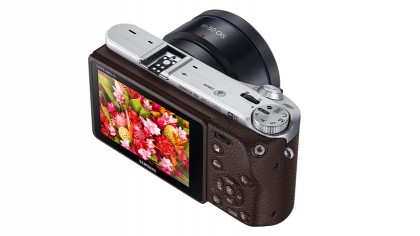
It’s worth noting that there’s a focal length conversion factor of around 1.68x (on top of the usual 1.5x caused by the APS-C format sensor) when shooting 4K video because the camera crops in to use 1:1 pixel recording rather than downsizing. While this means that composition changes if you switch from shooting stills to shooting 4K video, it should ensure higher quality movies than down-sampling.
This will change the effective focal length of your lenses. For stills photography the 16-50mm kit lens, for example, will have an effective focal length of 24-75mm, but if you switch to 4K video this becomes 40-126mm.
Wi-Fi, NFC and Bluetooth
Like most modern compact system cameras, the NX500 has Wi-Fi connectivity built-in, and as is becoming increasingly common there’s NFC (near field communication), but it’s also got Bluetooth connectivity that works with Android smart devices (not iOS). The advantage of using Bluetooth to connect to a smartphone is that there’s less drain on the battery and after it has connected once, it will do it again automatically.
Build and handling
Rather than having the SLR-like design of the NX1, the NX500 has the more rectangular shape of the NX300 and other entry-level/mid-range compact system cameras. Its metal body feels pretty solid, although there’s a faint clicking or creaking sound when you hold the grip tightly, suggesting that there’s a little bit of flex. Unlike the NX1, the NX500 isn’t weatherproofed.
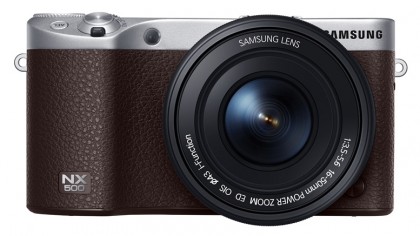
The front grip has a more defined edge than the NX300’s, which makes it more effective in your hand. Meanwhile on the back of the camera is a small but well-designed thumb-ridge which allows you to get a good grip.
Dials and buttons
Exposure mode can be selected quickly using the knurled metal dial on the far right of the top-plate. This dial doesn’t have a lock, but it isn’t knocked out of position very easily.
According to Samsung, the dial and button placement on the NX500 was in part determined by monitoring the brain responses of a collection of willing volunteers that the company wired up to find the most favourable location. Whether or not these people were photographers is unclear, but for the most part the NX500’s button arrangement is pretty good.
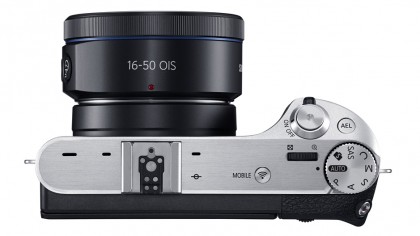
However, like the Sony Alpha 7 II, the video activation button is in a rather awkward position on the top corner of the thumb-ridge on the back of the camera. This means that if you’re hand-holding the camera your grip has to be adjusted to press the button and it could result in a bit of wobbling at the start and end of footage.
I also found the exposure compensation button rather awkward to use in the default set-up. This is on the back of the camera and it needs to be pressed down while rotating one of the command dials to adjust exposure. Thankfully it’s possible to customise the use of this button as well as the AEL (auto exposure lock) and the two command dials. I elected to set one of command dials to adjust exposure compensation directly when shooting in aperture and shutter priority mode.
Kit lens and iFn control
Samsung sells the NX500 with the 16-50mm f/3.5-5.6 Power Zoom ED OIS lens, and there’s no body only option (in the UK at least). This lens is a neat fit on the camera and it complements the size and style well. It’s also an i-Function optic, which means that there’s a button on the side of the barrel that can be used to control some camera features.
There are two options for using this button, iFn Standard or iFn Plus. In iFn Plus mode, pressing the iFn button changes the purpose of the exposure compensation and AEL button. It gives a quick means of adjusting two customisable features, but the 12 options available aren’t features I tend to change that often so I prefer to use the Standard option. In this mode, pressing the button turns the manual focus ring into a control dial capable of adjusting one of four features; aperture, sensitivity, exposure compensation and white balance. Repeated pressings of the button toggles through the options while turning the lens ring adjusts the setting.
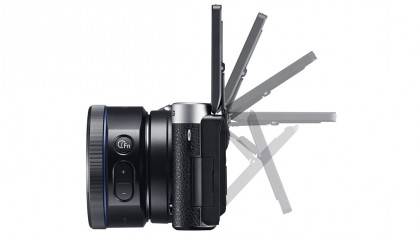
There’s also an Fn (Function) button on the camera body which brings up a maximum of 12 features for adjustment on the screen. Although several of the features have dedicated controls, I found this another convenient way of changing white balance, Picture Wizard (JPEG image style) and focus mode. It would be nice if this menu could be customised, so you have access to the features that you use most.
AMOLED display
The NX500 doesn’t have a viewfinder, so images must be composed on the AMOLED screen on the back of the camera. This is an excellent unit and when viewed straight-on it’s possible to see the scene even in quite bright light (when the screen’s brightness is boosted). The level of detail and clarity is impressive and it makes you want to take pictures because they look so good on-screen. However, in bright light it’s much less clear when viewed from a slight angle and reflections become very problematic.
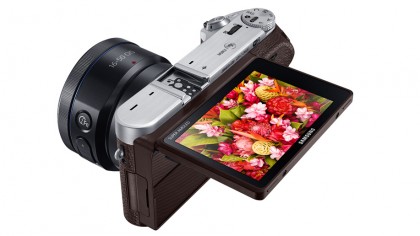
Fingerprints don’t help with the screen image’s visibility, so it’s worth carrying a cloth to give it a wipe occasionally because the touch-control is excellent – it’s very responsive and well implemented. When reviewing images a quick swipe of the screen scrolls to the next shot and a double tap zooms in. The main and function menus can also be navigated and features selected and adjusted by tapping or swiping the screen.
The menu is also very clear and generally well laid out, and most of the terms used are straightforward and not overly complex. A few, however, may have you checking the downloadable manual for an explanation. Framing Mode, for instance, rather than being an option to apply frames to your image or a method of adjusting aspect ratio, actually controls whether the screen displays the impact of exposure compensation adjustments or not.
An oddity that’s familiar from the NX1 is that Tracking AF mode is set via Touch AF options (along with Touch AF, AF point and One touch shot) in the main menu or via the screen icon. It’s not listed amongst the AF options accessible by pressing the AF button or the Function menu.
Another disappointment is that the camera’s level display was quite badly inaccurate straight out of the box and needed to be calibrated to avoid sloping horizons. I’ve consulted another reviewer about this and they had exactly the same problem. Happily the calibration process is very simple, but you would expect it to be set correctly in the factory.
Performance
Like the NX1, which shares the same sensor, the NX500 is capable of resolving a high level of detail. However, with the 16-50mm f/3.5-5.6 kit lens in place the extra 4 million effective pixels that it has over the Sony Alpha 6000 (with its comparable kit lens) don’t bring it a huge advantage in this respect. Our lab tests indicate that when the kit lenses are used these two cameras capture a similar level of detail up to ISO 800, but by ISO 1600 the NX500’s detail resolution drops below that of the Sony Alpha 6000’s.

Click here for a full size version.

Click here for a full size version.
For most of their sensitivity range the two camera’s images are a reasonably good match (bearing in mind the slight size difference) at 100%, but at ISO 6,400 and above (the A6000 tops out at 12,800), the Samsung camera’s images look a little coarser.
Nevertheless, even at ISO 25,600 the NX500 is capable of achieving a very respectable respectable score in our resolution tests, though the level of noise reduction applied to JPEG images shot at the uppermost sensitivity value (ISO 51,200) limits detail visibility at 100% on screen – the raw files fare rather better.
While Samsung’s noise reduction regime can look a little aggressive when examining JPEGs at 100% on screen, it’s worth remembering just how big the NX500’s images are and how far off from normal viewing sizes 100% is. At 300ppi, for instance, the 28Mp images make prints that measure 54.86 x 36.58cm or 21.6 x 14.4 inches.
Exposure accuracy
Though it’s worth keeping an eye on the histogram view and/or using the overexposure guide, I found the NX500’s 221-zone metering system generally does a good job in its Multi mode. Occasionally it’s also helpful to use the Exposure/Focus Separation option. When this is activated, touching the screen once sets the location of the AF point and puts a small right-angle icon next to it. When this icon is dragged the exposure metering point is separated from the AF point. This is useful, for example, if you want to focus on a very bright part of the scene and you want to set the exposure for a mid-tone area.

Click here for a full size version.

Click here for a full size version.
Wizards and white balance
The NX500 has a collection of Picture Wizards which determine the processing that’s applied to JPEG images. Rather oddly, though these can be turned off, there’s also an option called ‘Standard’. I haven’t spent ages investigating it, but the JPEGs captured when the Picture Wizard is turned off and in Standard Picture Wizard mode look pretty similar. Both seem to produce quite natural looking images in a range of conditions. It’s fun to experiment with the other options; Classic (monochrome), Vivid, Portrait, Landscape, Forest, Retro, Cool and Calm.

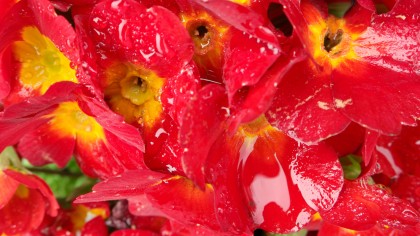
I especially like using the three Custom options to create different looks for images. It’s possible to adjust the saturation of the red, green and blue channels as well as overall saturation, sharpness, contrast and hue. The beauty of it is that you can record raw files at the same time as the JPEGs, so if you decide that don’t like the effect after all you still have a file with all the colour data to work with.
I found that the NX500’s automatic white balance system copes pretty well with most natural light situations, but it struggled a couple of times when shooting red flowers in overcast conditions, putting too much blue into the image and making them look purple/pink. Switching to the Daylight setting solved the problem.
Interestingly, the NX500’s Cloudy white balance setting produces much more subtly warmer images than many other cameras’. The difference in colour produced when using it and when using the Daylight setting is surprisingly slight. There are few occasions when I find other camera’s Cloudy setting useful because the result look excessively warm, but the NX500 is much better in this respect.
Autofocus in action
Like the NX1, the NX500 has an impressive autofocus system that’s capable of getting subjects sharp very quickly. With the kit lens mounted, the AF system becomes slower and less decisive in low light, but with the Samsung 50-150mm f/2.8 lens in place it’s better. It’s not quite up to the standard of the NX1, but still decent.
Unlike some compact system camera’s AF systems, the NX500’s does a good job of keeping moving subjects sharp, and the Tracking AF system works well – but the shape of the NX500 camera makes it less suited to shooting sport and action. Moving subjects are far easier to follow when you’re looking through/at a viewfinder.
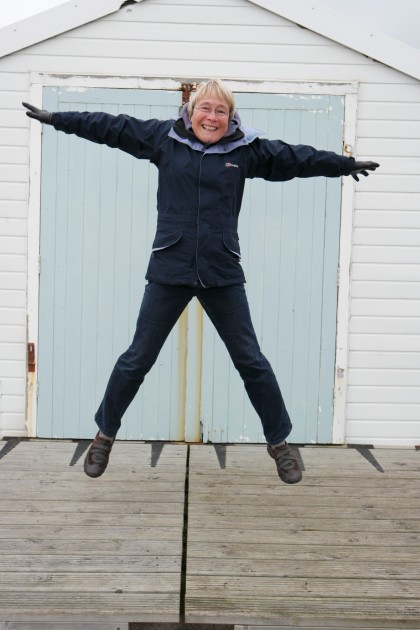
Click here for a full size version.
The Samsung Auto Shot (SAS) modes are rather gimmicky, but they can be good fun, especially Jump mode, which seems to be the most reliable. Trap mode appears to have quite a bit of potential, but it needs developing and being a bit more flexible because I found it rather hard to find many situations in which I’d want to use it as it stands. One potential use is to photograph a running race with the shot being taken when the runners cross the finish line. The problem is that because of the limitation in the direction of subject movement and the trigger position, it tends to produce images where the subject is heading out of the frame. In reality, it’s generally better to take action shots where the subject is moving from the edge of the frame towards the centre of the image.

Click here for a full size version.

Click here for a full size version.
As you’d expect, it’s easy to connect the NX500 to a smartphone, but I found a Wi-Fi connection more stable than Bluetooth when controlling the camera remotely.
I haven’t tested the video capability of the NX500 in depth, but it can produce high quality footage. Video enthusiasts are likely to be disappointed by the lack of external microphone and headphone ports, though.
Resolution
We test cameras for resolution, dynamic range and signal to noise ratio using laboratory test charts, measurements and analysis. We also pick three rival cameras so that you can instantly compare the performance of the test camera against it’s closest competitors.
For our Samsung NX500 comparison, we’ve chosen the Sony A6000, Panasonic GX7 and Olympus E-P5.
The Sony A6000 is Sony’s top APS-C format compact system camera, with a 24-megapixel sensor, state-of-the-art autofocus system and a viewfinder built in.
The Panasonic GX7 is Panasonic’s top compact-style compact system camera. It has a smaller Micro Four Thirds sensor than the Samsung and lower resolution, but it does have a viewfinder and high-end controls.
The Olympus E-P5 is two years old now, but it’s still Olympus’s top compact-style compact system camera. It’s solidly made with powerful features but, like the NX500, it lacks a viewfinder.
Resolution test
This is carried out in controlled lab conditions using an industry-standard resolution chart. The resolution is measured across the ISO range to test the camera’s performance at higher ISOs
The results are displayed as line widths/picture height, today’s universal standard for resolution measurement because it’s independent of sensor size, image size and megapixels. To put the results into context, a resolution of 3000 line widths/picture height is about as good as it gets for APS-C format cameras like the Samsung NX500.
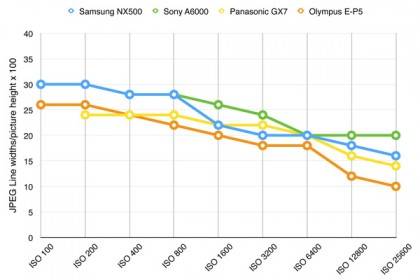
JPEG resolution analysis: With their 16-50mm f/3.5-5.6 kit lenses mounted the Sony A6000 and Samsung NX500 are capable of capturing a similarly high level of detail up to ISO 1600, when the NX500’s performance drops sharply. This is the impact of noise and noise reduction obliterating detail.
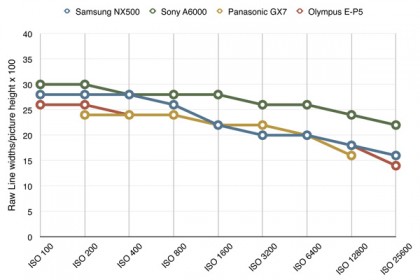
Raw resolution analysis: The pattern is broadly similar when comparing raw files (converted to TIFFs). This time the NX500’s drop off in performance at ISO 1600 is less noticeable, but the Sony A6000 has a clearer advantage throughout the ISO range. The two Micro Four Thirds cameras lag a little way behind in both the JPEG and raw tests, though they still perform well in absolute terms.
Dynamic range
Dynamic range is the camera’s ability to capture extremes of brightness. You see this on overcast days, when some cameras fail to capture detail across the whole sky and record some areas as a blank white, for example.
We test cameras scientifically using DxO Analyzer hardware and test processes, and here are the results from our four cameras.
Dynamic range test

JPEG dynamic range analysis: At the low to mid-range sensitivity settings the NX500 produces JPEGs with a wide range of tones. Again, its performance dips steeply at ISO 1,600. Its rivals deliver better dynamic range it higher ISOs.
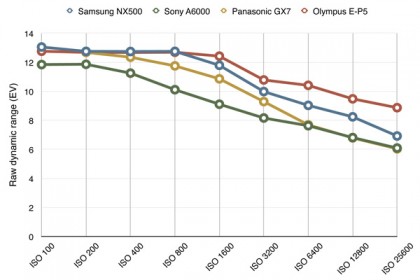
Raw dynamic range analysis: Up to and including ISO 1,600 the NX500 produces raw files (after conversion to TIFF) that have an impressive dynamic range, indicating that images have a wide range of tones and there’s good scope for post-capture contrast and brightness adjustment. At higher ISOs than this the dynamic range falls away, but it’s the same for its rivals.
Signal to noise ratio
The signal to noise ratio test measures the amount of random noise being produced in the image against the amount of real detail. The higher the figure, the greater the difference – and the less noise you’re going to see in your photos. Signal to noise ratio is the scientific way of measuring how noisy images look at different ISO settings.
Signal to noise ratio test
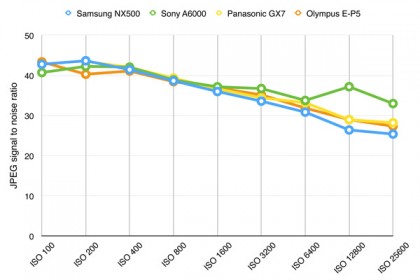
JPEG signal to noise ratio analysis: Having a very high pixel count means that the photo receptors are very small, even on a backside-illuminated sensor, and this makes it harder to control noise than with a lower resolution sensor. Nevertheless, the NX500 puts in a good performance in comparison with the 16MP Panasonic GX7 and Olympus E-P5 and 24MP Sony A6000.
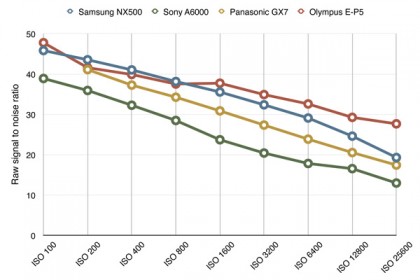
Raw signal to noise ratio analysis: The NX500 produces a strong signal to noise ratio at lower and mid-range sensitivity settings indicating that images are relatively clean, but its performance falls away progressively at higher ISOs. It is, however, almost the best in the group, and a very narrow second to the Olympus E-P5.
Verdict
At less than half the price, the NX500 offers a considerable saving upon the NX1. That price reduction comes at the cost of the viewfinder, a change in form factor and the loss of the weatherproofing, but you still get the same impressive sensor and a slightly modified processing engine. It also means that you can produce large, superb quality images and have access to some innovative features as well as fairly sensibly arranged user interface.
We like
With the exception of a viewfinder, the NX500 offers a pretty enticing collection of features. There are options and modes that will be attractive to both enthusiast and novice photographers and the autofocus system is very good, especially if you use one of Samsung’s faster optics.
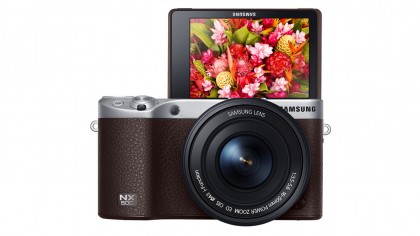

When the 16-50mm f/3-5-5.6 kit lens is mounted the NX500 feels very comfortable and secure in your hand, it’s also nicely balanced. The controls are generally sensibly arranged, but there is scope to customise their use to make things a little better. Samsung’s iFn control is especially useful for making quick settings adjustments on a relatively small camera that is likely to be held above or below head height, putting the buttons and dials on the top and back of the camera out of sight.
While not perfect, the camera’s interface is generally very clear and easy to use.
The AMOLED screen on the back of the camera is also excellent and, although it suffers from reflections that limit the viewing angle in direct sunlight, it provides a pretty good view in situations that other screens struggle with.
Samsung has some great ideas about how to make photography easy in some situations, and while they seem a bit gimmicky, they are a step in the right direction for many novices. It would be nice, however, if the Trap mode (and others which may come) could be made more flexible to make them more useful to experienced photographers.
We dislike
My biggest issue with the NX500 is its lack of a viewfinder. Several other similarly priced (or cheaper) cameras aimed at the same market, such as the Olympus OM-D E-M10, Sony Alpha 6000 and Panasonic GX7, all have viewfinders. The new Canon EOS M3, however, is another notable viewfinderless camera.
As well as providing a clear view of the scene in bright light, a viewfinder makes it easier to concentrate on the image that you’re composing and ignore any surrounding distractions. It’s also easier to hold a camera steady and follow a moving subject when a camera is held to your eye. Without a viewfinder it’s hard to get the full benefit of the NX500’s excellent autofocus system.

I’ve said on several occasions that Samsung needs to sort out an issue with its manual focus assist feature and it’s still something that still needs to be resolved with the NX500. Like many compact system cameras, when the NX500 is set to manual focus and manual focus assist mode is activated, the on-screen image is magnified to make it easier to see important details. Unlike other CSCs, however, it’s not possible to move the location of the magnified area and it stays locked in the centre of the frame. Naturally, you can use the ‘focus and recompose’ technique, but this is less than ideal when accurate focus is absolutely critical – for example with macro subjects.
Verdict
In many respects the NX500 is an excellent camera. It is capable of resolving a lot of detail, keeps noise under control well for most of the native sensitivity range and it has a good range of features including a very competent autofocus system. It’s also easy to use and has an excellent touch-screen as well as Samsung’s iFn control. The only disappointment is the lack of a viewfinder.
- Camera reviews
- Best mirrorless CSC
- Best camera
- Samsung NX1 review
![]()
Related Posts
December 6, 2021
7+ Web Design Trends for 2022: Which Will You Use?
December 6, 2021
The 10 Best WordPress Booking Plugins to Use On Your Website
December 6, 2021
How to Use a Web Cache Viewer to View a Cached Page
November 6, 2021
10 Modern Web Design Trends for 2022
November 6, 2021
Best Free SSL Certificate Providers (+ How to Get Started)
November 6, 2021
How to Design a Landing Page That Sends Conversions Skyrocketing
November 6, 2021
What Are the Best WordPress Security Plugins for your Website?
October 6, 2021
Your Guide to How to Buy a Domain Name
October 6, 2021
How to Build a WordPress Website: 9 Steps to Build Your Site
September 6, 2021
10 Best Websites for Downloading Free PSD Files
September 6, 2021
HTML5 Template: A Basic Code Template to Start Your Next Project
September 6, 2021
How Much Does It Cost to Build a Website for a Small Business?
September 6, 2021
A List of Free Public CDNs for Web Developers
September 6, 2021
6 Advanced JavaScript Concepts You Should Know
August 6, 2021
10 Simple Tips for Launching a Website
August 6, 2021
25 Beautiful Examples of “Coming Soon” Pages
August 6, 2021
10 Useful Responsive Design Testing Tools
August 6, 2021
Best-Converting Shopify Themes: 4 Best Shopify Themes
July 6, 2021
What Is Alt Text and Why Should You Use It?
July 6, 2021
24 Must-Know Graphic Design Terms
June 6, 2021
How to Design a Product Page: 6 Pro Design Tips
April 6, 2021
A Beginner’s Guide to Competitor Website Analysis
April 6, 2021
6 BigCommerce Design Tips For Big Ecommerce Results
April 6, 2021
Is WordPress Good for Ecommerce? [Pros and Cons]
March 6, 2021
Make Websites Mobile-Friendly: 5 Astounding Tips
March 6, 2021
Shopify vs. Magento: Which Platform Should I Use?
March 6, 2021
Top 5 Web Design Tools & Software Applications
February 6, 2021
Website Optimization Checklist: Your Go-To Guide to SEO
February 6, 2021
5 UX Design Trends to Dazzle Users in 2021
February 6, 2021
What Is the Average Page Load Time and How Can You Do Better?
February 6, 2021
Choosing an Ecommerce Platform That Will Wow Customers
February 6, 2021
7 Best Practices for Crafting Landing Pages with Forms
February 6, 2021
7 B2B Web Design Tips to Craft an Eye-Catching Website
January 6, 2021
Mobile-Friendly Checker | Check Your Site’s Mobile Score Now
January 6, 2021
8 Tips for Developing a Fantastic Mobile-Friendly Website
December 6, 2020
How to Add an Online Store to Your Website [4 Ways]
December 6, 2020
5 UX Design Tips for Seamless Online Shopping
November 6, 2020
Ecommerce Website Essentials: Does Your Site Have All 11?
November 6, 2020
5 Small Business Website Essentials You Need for Your Site
November 6, 2020
Your Website Redesign Checklist for 2020: 7 Steps for Success
May 1, 2020
Psychology of Color [Infographic]
April 21, 2020
How to start an online store that drives huge sales
January 3, 2020
5 Lead Generation Website Design Best Practices
March 6, 2019
6 Reasons You Should Redesign Your Website in 2019
March 6, 2019
7 Web Design Trends for 2019
February 19, 2019
Who owns the website/app source code, client or developer
February 7, 2019
Don’t Let Your Domain Names Expire in 2019
January 8, 2019
2019 Website Development Trends To Note
October 6, 2017
How Web Design Impacts Content Marketing
October 6, 2017
How to Choose a Navigation Setup
August 6, 2017
Why User Experience Matters to Marketing
July 6, 2017
5 Ways Web Design Impacts Customer Experience
September 6, 2016
How to Learn Angular
September 6, 2016
The Excuses for Not Having a Website (Infographic)
September 6, 2016
How to Build an Award-Winning Web Design Team
September 6, 2016
13 Free Data Visualization Tools
August 6, 2016
How Selling Pastries Helped Us Design a Better Product
August 6, 2016
11 Sites to Help You Find Material Design Inspiration
July 4, 2016
How to change free wordpress.com url
April 6, 2016
The 5 Best Free FTP Clients
April 6, 2016
7 Free UX E-Books Worth Reading
March 6, 2016
Can Handwritten Letters Get You More Clients?
December 10, 2015
Star Wars Week: How to create your own Star Wars effects for free
December 6, 2015
20 "Coming Soon" Pages for Inspiration
December 6, 2015
6 Free Tools for Creating Your Own Icon Font
December 6, 2015
9 Useful Tools for Creating Material Design Color Palettes
November 6, 2015
20 Free UI Kits to Download
November 6, 2015
50 Web Designs with Awesome Typography
November 6, 2015
When to Use rel="nofollow"
November 6, 2015
7 Free Books That Will Help You Become More Productive
November 6, 2015
50 Beautiful One-Page Websites for Inspiration
November 6, 2015
Circular Images with CSS
October 6, 2015
Lessons Learned from an Unsuccessful Kickstarter
October 6, 2015
5 Games That Teach You How to Code
October 6, 2015
Cheatsheet: Photoshop Keyboard Shortcuts
October 6, 2015
An Easy Way to Create a Freelance Contract for Your Projects
October 6, 2015
50 Design Agency Websites for Inspiration
September 29, 2015
JB Hi-Fi shutting the book on ebooks
September 24, 2015
Opinion: Quick, Quickflix: It's time to give yourself the flick
September 24, 2015
New Star Wars 360-degree video is among first on Facebook
September 21, 2015
Apple purges malicious iPhone and iPad apps from App Store
September 12, 2015
Apple's new Live Photos feature will eat up your storage
September 12, 2015
The latest Windows 10 Mobile preview has been delayed
September 12, 2015
IBM buys StrongLoop to add Node.js development to its cloud
September 8, 2015
Fake Android porn app takes your photo, then holds it ransom
September 6, 2015
50 Restaurant Websites for Inspiration
September 6, 2015
Zero UI — The Future of Interfaces
September 6, 2015
50 Beautiful Websites with Big Background Images
September 6, 2015
Infographic: 69 Web Design Tips
September 6, 2015
Free Windows 10 Icons
September 2, 2015
Instagram turns itself into a genuine messaging service
August 11, 2015
In Depth: How Microsoft taught Cortana to be more human
August 11, 2015
Windows 10 price, news and features
August 11, 2015
Windows 10's broken update introduces endless reboot loop
August 11, 2015
Windows 10 races to 27m installs
August 11, 2015
Windows 10 IoT Core gets first public release
August 10, 2015
iOS Tips: How to backup iPhone to an external drive
August 10, 2015
Windows 8.1 RT finally getting Windows 10 Start Menu
August 10, 2015
How to use Windows Hello
August 10, 2015
Review: Moto Surround
August 10, 2015
Review: Moto G (2015)
August 9, 2015
8 of the best free VPN services
August 8, 2015
Use Firefox? Mozilla urges you update ASAP
August 7, 2015
Mac Tips: Apple Mail: How to remove the Favorites Bar
August 7, 2015
How to make the OS X dock appear faster
August 7, 2015
Review: BQ Aquaris E45 Ubuntu Edition
August 7, 2015
Review: Acer Liquid Jade Z
August 6, 2015
How to reinstall Linux
August 6, 2015
How to reinstall Windows
August 6, 2015
Updated: Apple Music: release date, price and features
August 6, 2015
Social News Websites for Front-End Developers
August 6, 2015
10 Free JavaScript Books
August 6, 2015
50 Beautiful Blog Designs
August 6, 2015
Animated SVG Pipes Effect
August 6, 2015
Launching Your First App
August 5, 2015
Windows 10 goes freemium with paid apps
August 5, 2015
Updated: Week 1 with Windows 10
August 5, 2015
Mac Tips: How to manage Safari notifications on Mac
August 5, 2015
Microsoft Sway may kill the PowerPoint presentation
August 4, 2015
Microsoft gives Outlook on the web a new look
August 4, 2015
Mac OS X vulnerable to new zero-day attack
August 4, 2015
Windows 10 users warned of two scams
August 4, 2015
Microsoft's Docs.com is now available to everyone
August 3, 2015
Mac Tips: How to edit the Favorites sidebar on Mac
August 3, 2015
Updated: Windows 10 price, news and features
July 29, 2015
Review: HP ProDesk 405 G2
July 29, 2015
Hands-on review: HP Elite x2 1011
July 29, 2015
Hands-on review: Updated: Windows 10 Mobile
July 29, 2015
Review: Updated: Nvidia Shield Android TV
July 28, 2015
LIVE: Windows 10 launch: Live Blog!
July 28, 2015
How to prepare for your upgrade to Windows 10
July 28, 2015
Review: Updated: Windows 10
July 28, 2015
Review: Updated: HP Pro Tablet 608
July 28, 2015
Review: Heat Genius
July 28, 2015
Hands-on review: Moto X Play
July 28, 2015
Hands-on review: Moto X Style
July 28, 2015
Hands-on review: Moto G (2015)
July 28, 2015
Review: 13-inch MacBook Air (early 2015)
July 28, 2015
Hands-on review: OnePlus 2
July 28, 2015
Review: LG 65EG960T 4K OLED
July 28, 2015
Mac Tips: How to share printers on Mac
July 27, 2015
Apple Music's arrival hasn't opened Pandora's box
July 26, 2015
Review: Garmin Swim
July 25, 2015
How to merge OS X contacts into an existing list
July 25, 2015
Hands-on review: UPDATED: ZTE Axon
July 24, 2015
Mac Tips: How to zoom in on a Mac
July 24, 2015
What Windows 10 means for the enterprise
July 24, 2015
Review: JBL Charge 2 Plus
July 24, 2015
Review: Acer Aspire S7
July 24, 2015
Review: Updated: Canon G3 X
July 24, 2015
Review: Updated: iPad Air 2
July 24, 2015
Review: Thinksound On1
July 24, 2015
Review: Asus Chromebook Flip
July 24, 2015
Review: Garmin Forerunner 225
July 23, 2015
Review: Garmin nuvi 68LM
July 23, 2015
Review: Samsung Galaxy S6 Active
July 23, 2015
Review: Bowers and Wilkins P5 Wireless
July 23, 2015
Review: Dell XPS 15 (2015)
July 21, 2015
Review: Fuji S9900W
July 21, 2015
Review: Updated: Fitbit Surge
July 21, 2015
Review: UE Roll
July 21, 2015
Hands-on review: Ubik Uno
July 20, 2015
Review: Samsung HW-J650
July 20, 2015
Updated: 40 best Android Wear smartwatch apps 2015
July 20, 2015
Review: Acer Chromebook C740 review
July 20, 2015
Review: Huawei Talkband B2
July 20, 2015
Review: Dell Venue 10 7000
July 20, 2015
Review: Intel Core i7-5775C
July 17, 2015
Mac Tips: How to delete locked files on Mac
July 17, 2015
Review: Pebble Time
July 16, 2015
Microsoft just made Windows XP even less secure
July 16, 2015
Windows 8.1 RT is getting an update this September
July 16, 2015
OS showdown: Windows 10 vs Windows 8.1 vs Windows 7
July 16, 2015
Review: Acer CB280HK
July 15, 2015
Windows 10 is ready for new laptops and PCs
July 15, 2015
Explained: How to take a screenshot in Windows
July 15, 2015
Office for Windows 10 appears in latest build
July 14, 2015
Review: ZTE Axon
July 14, 2015
Review: ViewSonic VP2780-4K
July 14, 2015
Hands-on review: SanDisk Connect Wireless Stick
July 14, 2015
Review: Oppo PM-3
July 14, 2015
Review: BT 11ac Dual-Band Wi-Fi Extender 1200
July 14, 2015
Review: Fuji X-T10
July 13, 2015
How to build an SEO strategy for your business
July 13, 2015
Review: Lenovo ThinkPad Yoga 15
July 13, 2015
Review: Audio-Technica ATH-MSR7
July 13, 2015
Review: Garmin NuviCam LMT-D
July 13, 2015
Review: Dell Inspiron 13 7000
July 13, 2015
Hands-on review: AstroPi SenseHAT
July 13, 2015
Hands-on review: EE Rook
July 13, 2015
Hands-on review: Updated: HTC Vive
July 12, 2015
Here's the ultimate software list for PC fanatics
July 10, 2015
How to use the new Photos app for Mac
July 10, 2015
Windows 10 Insider Preview Build 10166 available now
July 10, 2015
Splunk spends big on cybersecurity acquisition
July 10, 2015
Making Windows 10 apps just got a whole lot easier
July 10, 2015
Review: Lenovo LaVie Z 360
July 9, 2015
OS X El Capitan public beta available right now
July 9, 2015
Microsoft finally unveils Office 2016 for Mac
July 9, 2015
Review: Updated: Chromecast
July 9, 2015
Review: Updated: Tesco Hudl 2
July 9, 2015
Review: Lenovo ThinkPad E550
July 9, 2015
Review: Updated: Google Nexus 6
July 8, 2015
What you need to know about Windows Server 2016
July 7, 2015
Microsoft to hike enterprise cloud pricing
July 6, 2015
Hacking Team end up being totally 0wned
July 6, 2015
Review: HP Pro Slate 12
July 6, 2015
Review: Samsung 850 Pro 2TB
July 6, 2015
Review: Asus RT-AC87U
July 6, 2015
Review: Jawbone UP2
July 6, 2015
Reimagining the Web Design Process
July 6, 2015
50 Clean Websites for Inspiration
July 6, 2015
15 Free Books for People Who Code
July 6, 2015
Web Storage: A Primer
July 6, 2015
A Look at Some CSS Methodologies
July 3, 2015
6 Essential Mac Mouse and Trackpad Tips
July 2, 2015
How to install a third party keyboard on Android
July 2, 2015
Review: UPDATED: Asus Zenfone 2
July 2, 2015
Review: Alienware 13
July 2, 2015
Review: HP DeskJet 1010
July 1, 2015
5 issues we want Apple Music to fix
June 13, 2015
Cortana will get its own button on Windows 10 PCs
June 12, 2015
Windows 10 will come with universal Skype app
June 12, 2015
iPad music production: 18 Best apps and gear
June 12, 2015
Windows 10 all set for early enterprise struggle
June 12, 2015
Review: Garmin VIRB Elite
June 11, 2015
Review: Updated: Nvidia Shield Tablet
June 11, 2015
Review: Nokia Lumia 635
June 10, 2015
Microsoft brings more online tweaks to Office 365
June 10, 2015
Mac Tips: How to use Screen Sharing in Mac OS X
June 9, 2015
Hands-on review: Meizu M2 Note
June 9, 2015
Hands-on review: EE 4GEE Action Camera
June 9, 2015
Review: Toshiba 3TB Canvio external hard drive
June 9, 2015
Review: Olympus SH-2
June 8, 2015
Hands-on review: Updated: Apple CarPlay
June 8, 2015
UPDATED: iOS 9 release date, features and news
June 8, 2015
Review: Updated: Roku 2
June 8, 2015
Review: Updated: PlayStation Vue
June 8, 2015
Review: Dell PowerEdge R730
June 8, 2015
Review: Canon SX710 HS
June 7, 2015
UPDATED: iOS 9 release date, features and rumors
June 7, 2015
Review: Lenovo S20-30
June 6, 2015
Free Writing Icons
June 6, 2015
15 CSS Questions to Test Your Knowledge
June 6, 2015
The Best CSS Reset Stylesheets
June 6, 2015
How CSS Specificity Works
June 5, 2015
'Delay' is a new feature in Windows 10
June 5, 2015
Review: Beyerdynamic Custom One Pro Plus
June 5, 2015
Latest SEO Marketing tools
June 5, 2015
Review: Nvidia Shield Android TV
June 5, 2015
Review: Honor 4X
June 5, 2015
Review: In Depth: Oppo R5
June 3, 2015
Hands-on review: Huawei P8 Lite
June 3, 2015
How To: How to create eBooks on a Mac
June 3, 2015
Review: Updated: Tidal
June 3, 2015
Review: Canon 750D (Rebel T6i)
June 2, 2015
Review: Updated: Asus ZenWatch
June 2, 2015
Review: Alcatel OneTouch Idol 3
June 2, 2015
Review: Updated: Nokia Lumia 1520
June 2, 2015
Review: Updated: Yotaphone 2
June 2, 2015
Review: Updated: Nokia Lumia 625
June 2, 2015
Review: Creative Muvo Mini
June 1, 2015
Review: Acer TravelMate P645 (2015)
June 1, 2015
Hands-on review: Corsair Bulldog
May 29, 2015
In Depth: NetApp: a requiem
May 29, 2015
July is looking definite for Windows 10 release
May 29, 2015
Hands-on review: Google Photos
May 28, 2015
Mac Tips: The 16 best free GarageBand plugins
May 28, 2015
Review: Canon 760D (Rebel T6s)
May 27, 2015
Review: Lenovo Yoga 3 14
May 27, 2015
Hands-on review: Serif Affinity Photo
May 27, 2015
Review: Garmin Vivoactive
May 26, 2015
Review: Datacolor Spyder5 Elite
May 26, 2015
Hands-on review: Sony Xperia Z3+
May 26, 2015
Review: Epson BrightLink Pro 1410Wi
May 26, 2015
Review: Technics Premium C700
May 26, 2015
Review: Canon EOS M3
May 26, 2015
Review: Updated: HTC One M9
May 26, 2015
Review: Updated: Sony Xperia Z3 Compact
May 25, 2015
Review: Updated: New Nintendo 3DS
May 25, 2015
Updated: 50 best Mac tips, tricks and timesavers
May 25, 2015
Updated: Windows email: 5 best free clients
May 25, 2015
Instagram is planning to invade your inbox
May 25, 2015
Review: Updated: Foxtel Play
May 24, 2015
How Windows 10 will change smartphones forever
May 24, 2015
Review: Vodafone Smart Prime 6
May 24, 2015
Review: Updated: iPad mini
May 22, 2015
Office Now may be Cortana for your work life
May 22, 2015
Review: Updated: Lenovo Yoga 3 Pro
May 22, 2015
Review: Microsoft Lumia 640 LTE
May 22, 2015
Review: Updated: Fitbit Flex
May 21, 2015
Updated: Best free Android apps 2015
May 21, 2015
Review: Asus ZenBook Pro UX501
May 21, 2015
Review: Sennheiser Momentum In-Ear
May 20, 2015
Hands-on review: UPDATED: Asus Zenfone 2
May 20, 2015
OS X 10.11 release date, features and rumors
May 18, 2015
Updated: Best free antivirus software 2015
May 18, 2015
iPhone 6S rumored to launch as soon as August
May 18, 2015
Microsoft ready to pounce and acquire IFS?
May 17, 2015
5 of the most popular Linux gaming distros
May 16, 2015
Review: Acer Chromebook 15 C910
May 16, 2015
Review: Lenovo ThinkPad X1 Carbon (2015)
May 16, 2015
Review: Polk Nue Voe
May 16, 2015
The top 10 data breaches of the past 12 months
May 16, 2015
Hands-on review: Updated: LG G4
May 16, 2015
Review: Updated: Quickflix
May 16, 2015
Review: LG Watch Urbane
May 16, 2015
Review: Razer Nabu X
May 16, 2015
Hands-on review: Updated: Windows 10
May 16, 2015
Review: UPDATED: Moto X
May 16, 2015
Review: Updated: Moto G (2013)
May 12, 2015
Review: TomTom Go 50
May 12, 2015
Review: Updated: Moto G (2014)
May 12, 2015
Review: Garmin Vivofit 2
May 12, 2015
Review: Asus Transformer Book Flip TP300LA
May 11, 2015
Review: MSI GT80 Titan
May 11, 2015
Review: Monster SuperStar BackFloat
May 9, 2015
Review: Updated: Apple Watch
May 7, 2015
5 million internet users infected by adware
May 7, 2015
Review: Updated: New MacBook 2015
May 6, 2015
Android M will be shown at Google IO 2015
May 6, 2015
Review: Epson WorkForce Pro WF-4630
May 6, 2015
Review: Master & Dynamic MH40
May 6, 2015
How to Use Gulp
May 6, 2015
Getting Started with Command-Line Interfaces
May 6, 2015
What It’s Like to Contribute to WordPress
May 6, 2015
Ultimate Guide to Link Types for Hyperlinks
May 6, 2015
11 Things You Might Not Know About jQuery
May 5, 2015
Hands-on review: Updated: PlayStation Now
May 5, 2015
Review: Lenovo ThinkPad Yoga 12
May 5, 2015
Review: Updated: iPad Air
May 5, 2015
Review: Panasonic SZ10
May 5, 2015
Review: Updated: Fetch TV
May 4, 2015
Review: Cambridge Audio Go V2
May 3, 2015
Review: Lightroom CC/Lightroom 6
May 2, 2015
5 of the most popular Raspberry Pi distros
May 1, 2015
Review: PlayStation Vue
May 1, 2015
Hands-on review: Updated: Microsoft HoloLens
April 30, 2015
Build 2015: Why Windows 10 may not arrive until fall
April 29, 2015
The biggest announcements from Microsoft Build 2015
April 29, 2015
Hands-on review: TomTom Bandit
April 29, 2015
Hands-on review: EE Harrier Mini
April 28, 2015
Hands-on review: LG G4
April 28, 2015
Review: Patriot Ignite 480GB SSD
April 28, 2015
Hands-on review: EE Harrier
April 28, 2015
Review: Linx 10
April 28, 2015
Review: 1&1 Cloud Server
April 26, 2015
Hands-on review: Acer Iconia One 8
April 25, 2015
How to run Windows on a Mac with Boot Camp
April 24, 2015
Dropbox Notes poised to challenge Google Docs at launch
April 24, 2015
Hands-on review: Acer Aspire E14
April 24, 2015
Hands-on review: UPDATED: Valve Steam Controller
April 24, 2015
Review: Acer Iconia One 7
April 23, 2015
Windows 10 just revived everyone's favorite PC game
April 23, 2015
Google opens up Chromebooks to competitors
April 23, 2015
Here's how Outlook 2016 looks on Windows 10
April 23, 2015
Hands-on review: Updated: Acer Liquid M220
April 23, 2015
Hands-on review: Acer Aspire Switch 10 (2015)
April 23, 2015
Hands-on review: Acer Aspire R 11
April 22, 2015
Review: Alienware 17 (2015)
April 22, 2015
Hands-on review: Updated: HP Pavilion 15 (2015)
April 21, 2015
This is how Windows 10 will arrive on your PC
April 21, 2015
Review: iMac with Retina 5K display
April 21, 2015
Review: Epson XP-420 All-in-One
April 18, 2015
Google Now brings better search to Chrome OS
April 17, 2015
Review: Epson Moverio BT-200
April 17, 2015
Review: Pentax K-S2
April 16, 2015
Updated: Android Lollipop 5.0 update: when can I get it?
April 15, 2015
Hands-on review: Updated: Huawei P8
April 15, 2015
Review: SanDisk Ultra Dual USB Drive 3.0
April 15, 2015
Review: Updated: LG G3
April 15, 2015
Review: Updated: LG G3
April 15, 2015
Review: Crucial BX100 1TB
April 13, 2015
iOS 8.4 beta reveals complete Music app overhaul
April 13, 2015
Linux 4.0: little fanfare for a tiny new release
April 13, 2015
Achievement unlocked: Microsoft gamifies Windows 10
April 13, 2015
Best Android Wear smartwatch apps 2015
April 13, 2015
Review: Acer Aspire R13
April 12, 2015
Review: TP-Link Archer D9
April 10, 2015
Microsoft's new browser arrives for Windows 10 phones
April 10, 2015
Review: LG UltraWide 34UC97
April 9, 2015
Office now integrates with Dropbox on the web
April 9, 2015
Now you can buy video games with Apple Pay
April 9, 2015
Updated: iOS 8 features and updates
April 9, 2015
Microsoft's stripped down Nano Server is on the way
April 8, 2015
Skype Translator gets even more features
April 8, 2015
Windows mail services hit by widespread outages
April 8, 2015
Review: UPDATED: Amazon Echo
April 8, 2015
Hands-on review: Dell Venue 10 7000
April 8, 2015
Review: Updated: OS X 10.10 Yosemite
April 7, 2015
Google's GMeet could kill teleconferencing
April 7, 2015
Is Redstone the first Windows 10 update?
April 7, 2015
Next peek at Windows Server 2016 due next month
April 7, 2015
Review: Acer Aspire Switch 11
April 7, 2015
Review: Adobe Document Cloud
April 6, 2015
Hands-on review: Updated: New MacBook 2015
April 6, 2015
Freebie: 100 Awesome App Icons
April 6, 2015
Six Revisions Quarterly Report #1
April 6, 2015
A Modern Approach to Improving Website Speed
April 6, 2015
Disable Text Selection with CSS
April 4, 2015
Review: Nikon D7200
April 3, 2015
Amazon Prime video now streams to any Android tablet
April 3, 2015
Review: Google Cardboard
April 3, 2015
Review: MSI WS60
April 2, 2015
Chrome users can now run 1.3 million Android apps
April 2, 2015
See Windows 10 Mobile running on an Android handset
April 2, 2015
Review: Mini review: Macphun Noiseless Pro 1.0
April 2, 2015
Review: Intel SSD 750 Series 1.2TB
April 2, 2015
Review: BenQ TreVolo
April 2, 2015
Hands-on review: Nikon 1 J5
April 1, 2015
Microsoft launches Windows 10 music and video apps
April 1, 2015
Review: mini review: Sony XBA-H1
December 19, 2014
Review: CoPilot Premium sat nav app
December 19, 2014



























































































































































































































































































































































































































































































































































































